This blog is actively maintained by team members of My Crystal Bridge. The blogs provide insight information on Chinese screens, Chinese culture, history, arts and crafts. If you like to comment on any contents in this blog, please email the webmaster. Thanks.
![]() Subscribe to blog RSS feed: copy and paste the following URL to your favorite RSS feed reader
"http://www.mycrystalbridge.com/blog-feed.rss"
Subscribe to blog RSS feed: copy and paste the following URL to your favorite RSS feed reader
"http://www.mycrystalbridge.com/blog-feed.rss"

2010 Blog archives
9. Xue Bao Bao Ding Beryl Crystal Mines - June. 2010
Beryl Crystals are some of the most striking crystals in the world. One of the most famous mines that actively provisions them to the world is the Xue Bao Ding Beryl Crystal mines in the Sichuan Province of China. Xue Bao Ding Beryl Crystal mines have become well known among many western mineral collectors. These mines produce the clearest and brightest of the Beryl Crystals.
While there are mines in other parts of the world such as South Africa and the United States, the Chinese mines are the most glorified. A few of the local destinations that provide the orange crystals are "Pingwu", "Songpan", "Mount Xue Bao Ding" and "Huya". The mines produce some of the largest productions of Beryl crystals. Xue Bao Ding is the most prominent mine for providing a source of scheelite. This mine lines in the autonomous part of Tibetan Aba Prefecture.
The mines are located in a 5, 588 meter high mountain and the mountain cap is covered with year round snow. The mountain is also one of the highest peaks in the Sichuan Province. The area around the Xue Bao Ding Beryl Crystal mines is being developed by the Government as a prime tourist destination.

Especially the area around the small town of Songpan, which is called Munigou, has a charismatic feeling that allows people to feel at home. It has attracted nature lovers from all over the world. It is also a dream destination for mineral lovers to find their crystals directly at the foot of the mountain. The best thing about these mines is that the natural beauty surrounding the mines has not been destroyed, as it often is the case with western mines in other countries.
With the help of the Chinese government and savvy marketing from trace groups, these Chinese Beryl crystals have become very popular. A few of the most popular types of crystals that come from the Xue Bao Ding mines are clusters of milky white crystals, creamy yellow crystals, transparent crystals, transparent light blue crystals, transparent yellow crystal bundles and others.
Our beryl crystal specimens are all sourced from the Xue Bao Ding mines. Although they are thousands miles away from the mountains where they had been laying for centuries, you can still find traces of the raw beauty and the determined force of Mother Nature in these specimens.

8. Technology Advances in Golden Age Tang Dynasty- June 2010
Tang dynasty (618 - 907) of China was one of the golden times in Chinese history. Political stability and advancements had enabled technology, literature, science, culture, music and art to sprout and blossom.
The technology of China became very well developed during the Golden Age of the Tang Dynasty. The Tang Chinese developed new techniques for salt mining (and as a result of the search for salt, developed methods of drilling for natural gas - tapping the earth to a depth of almost one kilometer.
One of the major technological advances of the Tang Dynasty was the invention of woodblock printing. This invention aided the Tang both in the creation of a civil service and a government - because they were able to standardize the classical texts necessary for civil service examinations - and in continuing to record and standardize and codify their knowledge in general. Below is a pictures of a collection of woodblocks with Chinese characters carved in reverse.
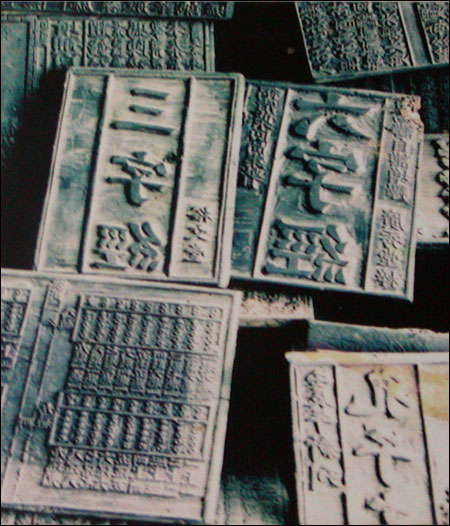
They also had mechanical clocks - at first they had water clocks, but they developed also springs and spring wound clocks. They understood the concept of the pendulum.
The Tang Chinese also made medical advances - they knew that people who suffered from diabetes should not eat starchy foods or drink alcohol, and they were able to cure goiter using the thyroid hormone from pigs and sheep. They developed and codified a materia medica and the equivalent of a modern Physician's Desk Reference. They understood the health effects of various herbs.
The Tang Chinese traded with the Ottoman Turks, the Persians, the Eastern Byzantine Empire, and the Western European countries and city states via a well guarded, heavily taxed Silk Road. Since the Tang was at the endpoint of the Silk Road, they had access to many different cultures and to the technology of many different cultures. They had the advanced mathematical capability of the Ottoman Turks (although it is not certain if they ever developed the differential equation, the basis for calculus. If they did, they didn't think much of it, for there is no written record. But one could guess that they might have developed it at some point during the 300 years of Tang rule.)
There were advances in astronomy and therefore in the navigation of ships. They were the first to trace the meridian line on the ground, they developed extremely accurate star maps, and developed the concept of the telescope which they borrowed from the Ottomans and refined. See below murual picture of a Tang Dynasty ship being sheered by onlookers.
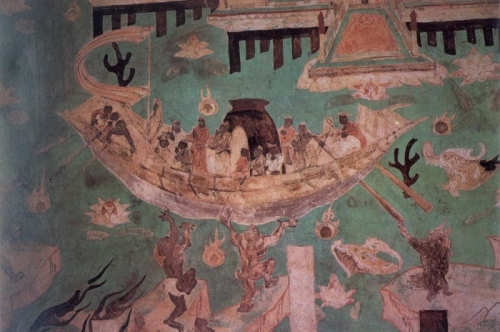
One of the things that happened as a result of the technological advances of the Tang period was the philosophical change in Chinese society. By the end of the Tang and the beginning of the Song Dynasty, Buddhism, with its emphasis on disengagement from the humanistic world as a means of spiritual purification, had fallen out of favor - this was probably a direct result of the reprinting of the works of Mencius and others from the Confucian period. The Neo-Confucianism of the mid to late Tang Dynasty and the Song Dynasty philosophically described life in China better than Buddhism - it became clear to the ever more cosmopolitan Chinese urbanites of the time that being a Buddhist monk conferred no special purity.
Gun powder was invented by the Chinese in Tang Dynasty. It was originally used in fire crackers to repel evils and ghosts. It's not until another golden dynasty - the Song dynasty that Chinese began to make canons utilizing gun powders. See picture below for Tang dynasty kids playing with fire crackers.
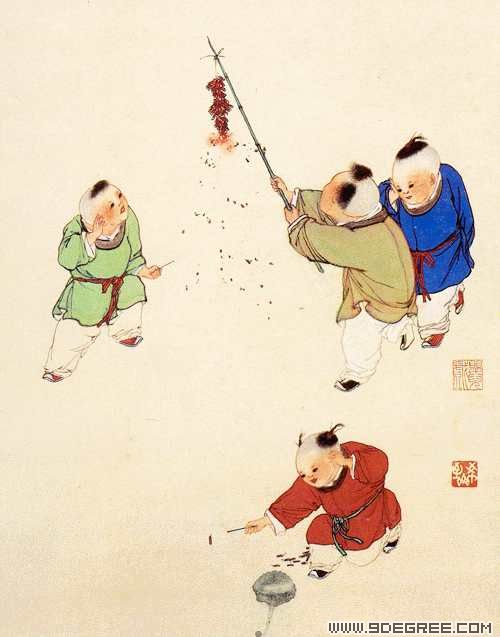
Ultimately, the Song Dynasty fell to the Mongols, and the Mongols turned the Han Chinese' own great weapon against them - gunpowder. The Mongols used ordinance; they used artillery that a US Army Gunner of today would understand the workings of. Although the Tang was three centuries gone by the point of the Mongol invasion of China, the Song dynasty that followed was also a kind of golden age for China during which Neo-Confucianism was the prevailing thinking and the Chinese were hundreds of years ahead of Western Europe technologically.
In a way, the weapons that kept Chinese order against anti-government rural peasant rebellions and civil unrest, the weapons that the Chinese used to keep a tight grip on their empire, became their undoing. The Chinese could not keep the secrets of gunpowder to themselves, and ultimately that was what destroyed parts of the Great Wall and let the Mongols in.

7. Traditional Chinese medicine and crystals - May 2010
Chinese traditional medicine holds that illness and disease spring from improper flow of chi. The term chi does not translate directly into English as it is a concept with a multilayered and heavily subtextual meaning. Loosely, chi translates as "life force" or "soul force" or "the river of force that makes living things alive". It can also be translated as "go power" or "the thing that makes living things go" or "the thing that enables living things to propel themselves".
However you translate it, traditional Chinese medicine held that bodily illnesses occurred because of improperly flowing chi. Chinese medicine holds that the human body lives under the direct influence of its environment or habitat and that psychological and physical problems can result in improper flow of chi when the environment is not right.The basics of Chinese traditional medicine were laid down about 2000 years ago in the text called the Huang di nei jing - "The Yellow Emperor's Inner Canon". The book is a series of dialogues between the legendary Yellow Emperor of China and his philosophers Qi Bo, Le Gong, and others. The Yellow Emperor begins by asking why "in the old days": people lived to one hundred and fifty without showing signs of age but in "modern" times people look old and die at fifty. It goes on to talk about organ health, treatment, manipulation of chi within the body and other topics.
The book is believed to be one of the first human attempts to codify medical knowledge into a consistent logical system. In this sense it is on a par with works by people like Hippocrates and Galen - it is one of the oldest codified systems of medicine in the world. Some scholars - notably Nathan Sivin at the University of Pennsylvania believe that the modern translations of what we call the "Huangdi neijing" are actually compilations, and that the text that existed during the Han Dynasty was a different text of which the modern text may contain only parts or fragments.
To illustrate what is meant by "harmony with one's environment" in traditional Chinese medicine, I've included a translation of one of the "treatises" in the Huang di nei jing.

In other words, as goes the universal environment, so goes the human body. If the "yang qi" of the universe/environment flows improperly so does the yang qi of the people living in it. (Incidentally, this is where feng shui comes from - a codified system of interior decoration to best manipulate the flow of chi).
To learn more about Traditional Chinese medicine, check out an expereinced Chinese doctor and accupunturists - Dr. Tian LongDu's website. Dr. Du has more than 40 years of experience in western and TCM treatment. He has established his accupuncture clinic in Roswell (greater Atlanta), Georgia for 10 years.
Beryl is classified in Chinese medicine as being part of the water element. It is believed to be good for the throat, for sexual potency, and for redirecting chi (emeralds, a rare green form of beryl, are believed by practitioners of traditional Chinese medicine to be able to expel or dispel evil spirits from a person or place).
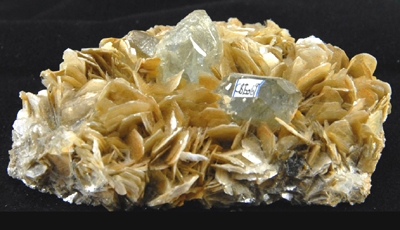
Now obviously, we can't make any medical claims whatsoever about our beryl crystals. Medical problems are best handled by a doctor. But our beryl crystals give a warm, golden light to any room - just put them in a sunbeam and watch them sparkle with a nice, milky glow. They can make a house feel more like a home and brighten up any room. Check them out here.

6. Chinese Screens - May 2010
Chinese screens have a long history. They date back almost 2000 years . In the beginning they were used emperors and nobles as a symbol of power, authority and wealth. It wasn't until the Tang Dynasty (618-907) that screens began to be available to average people.
The function of a screen in Chinese interior decoration is to provide background (such as the screens behind a throne). They were also used as wall panels, space dividers, doorway greetings or simply for decoration.


There are different types of screens - vertical screens, inserting screens and folding screens. Vertical screens are usually used as the backdrop of a sitting area, like a parlor. Inserting screens are panels inserted into lavishly made stands. They are usually not very tall and mostly used for decoration. Folding screens are the ones that divide a space such as a restaurant or home or place of business in two - leaving it to the imagination of the patrons or guests to wonder what or who is on the other side of the screens.
Here is an example of inserting screens - Wood Screen Inlaid with Stained Ivory, Jade, collection of the Palace Museum
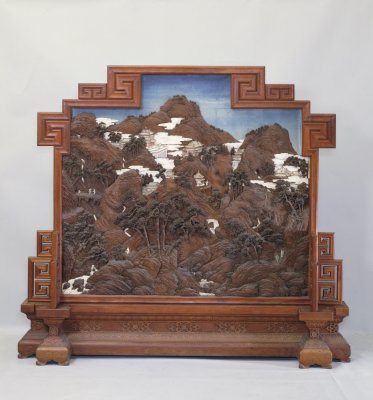
The frames of Chinese screens are made from all sorts of high quality fine grain woods and the screen panels can be made from a wide variety of materials - wood, stone, bamboo, silk, paper, cotton, and more.
The screens were decorated with carvings, paintings, calligraphy, inlaid gem stones and sometimes lacquer. These different designs of screens reveal the social status, taste, personality, or life experience of the homeowner who would spend a lot of time and money to create screens that reflected him uniquely.
In modern China, there has been a revival of interest in classical screens in recent years. One of the reasons for that probably is that living spaces in China have become bigger and it makes sense to use a screen to divide the room to two - for example, dividing the dinning room from the kitchen.
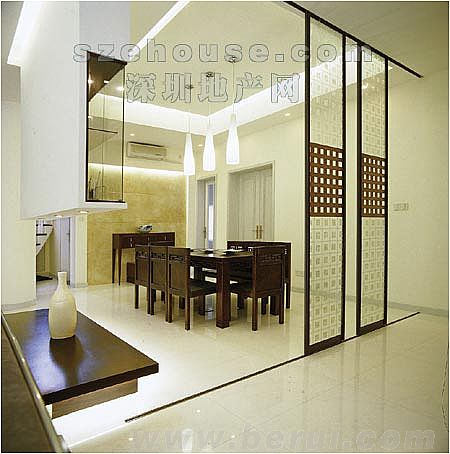
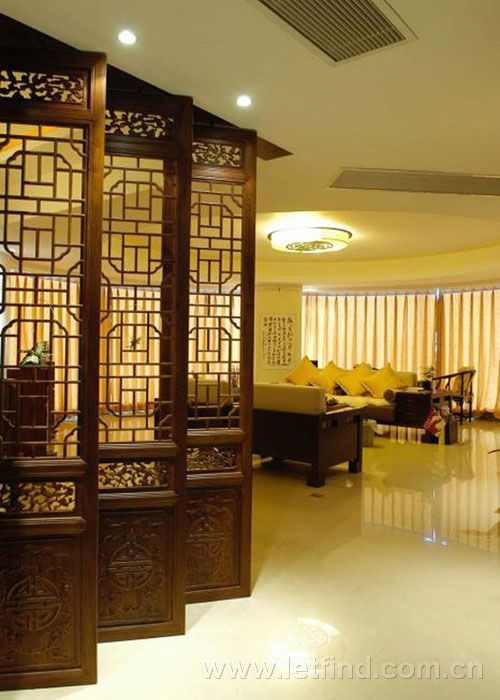
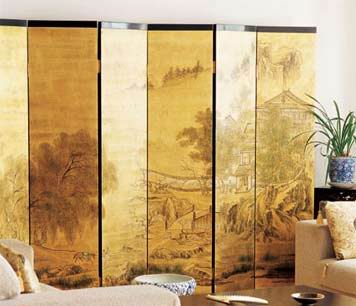
And even more likely reason for screens than the larger living spaces isthe sense of mystery that is provided by the screens. Chinese people are usually very private people. They like to create a space for themselves away from the public eye. By putting a screen in the living room, they can always retreat to the area behind the screens if they have to converse amongst themselves away from the guests. Also, by putting a screen right at the entrance to a court yard, the host can check his appearance, prepare his speech before he meets his guests, but after he hears their footsteps.
The other purpose of putting a screen as doorway greetings is that the host expresses his welcome to his guests but at the same time to hint the guests that this is his territory and the guests are not free to poke around.
A famous Westerner from a totally different culture also adored Chinese screens. Coco Chanel had a quite impressive collection of 17th (Qing KangXi reign) century Chinese lacquered folding screens in her Paris apartment. See a pictucre of one of her screens below,
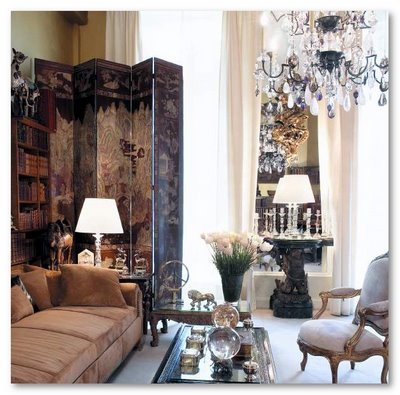
Read more about Coco Chanel's screens in this wonderful blog.
The best way to understand a Chinese classical screen is to get one for yourself and place it somewhere in your home then let your thoughts flow to the far away ancient times and lives of the people who lived around these screens. Han China has an old culture, very different than the young, exuberant, vivacious culture of the West. One of the keys to understanding Chinese culture is to understand subtlety and fine divisions between concepts. The screens are an example of that - they provide privacy and send signals to guests and patrons in a subtle way.

5. Chinese Calligraphy - April 2010
Chinese classical calligraphy is a highly structured, stylized, elegant system of writing classical Chinese characters. The characters are created with brush strokes.
Interestingly enough, the beauty of classical Chinese calligraphy does not come from symmetry and regularity. It comes from beautiful asymmetry and irregularity. When Chinese calligraphy is well done, there is a roughness to the characters that is the artist's means of expression. Chinese calligraphy is similar to abstract painting (and in fact it forms the basis of Chinese abstract painting.) What the word is - or the meaning of the characters does not matter so much as how those characters are expressed. The same characters can be expressed in many ways and styles - playfully, angrily, sensually, and so on. An artist's skill lies, as always, in his ability to manipulate the medium and say what he wants to say the way he wants to say it.
Tu Meng, writing during the T'ang Dynasty developed 120 ideas or what might be called aphorisms related to Chinese calligraphy. He gave examples and descriptions of each. Reproduced below are the first five on his list.

Chinese classical calligraphy often is done the same way every time - in much the same sense that in English literature, a sonnet always takes the same form. The form has a very strict meter and always ends with a rhymed couplet. If the poet does not take that form and that meter, he has not written a sonnet. But within that sonnet, he has the freedom to say anything he likes, any way he wants to say it. People have experimented by writing, for instance, 14 lines of basic phonological /alliterative blank syllable verse ending in a rhymed couplet. This is a sonnet and has virtue.
So it goes with Classical Chinese calligraphy. An artist is free to say anything he likes any way he likes to say it as long as he follows the form. The form is very strict and usually the brush strokes that make up the characters are laid in the same way every time, in the same order.
In Chinese calligraphy, the basic tools are: page, paperweight, desk pad, ink stick, brush. The ink stick is solid material that is ground into usable ink by the paperweight.
The best Chinese calligraphy has a rhythm and a balance to its creation and execution. To watch a calligrapher is to watch someone who does not waste motion or break his rhythm. It's like watching a dancer - he is engaged in the rhythm of creation and expression.
To say, as many Westerners do, that Chinese are inscrutable or reserved is incorrect; it is a misnomer. By way of example.American art springs from a young, vibrant, raucous, sometimes raunchy, scruffy culture. (These are not bad things; they have been the wellspring of amazing art). American art springs from a culture that is young and unrestrained - it is more akin to Hemingway in Paris or Van Gogh in Arles. Chinese art is more like Pablo Picasso in Mougins - older, more careful, less explosive, greater mastery of the medium, more technically skilled - more able to express complex ideas in a given medium more easily.
Chinese culture is 5000 years old. The view of art is a more mature view. To say it is "better" than the American view is likewise a misnomer. Some like Beaujolais Noveau, tight, a clean, new grape that beguiles the tongue and makes youthful the heart. Some like Armagnac 1947 Vaghi Baron de Sigognac, older, well developed vintage with a deeper spirit and a finer grained soul. It is a matter of preference.
Here is a finished calligraphy writing of a famous contemporary Chinese calligrapher, Mr. Cao, Bao Lin.
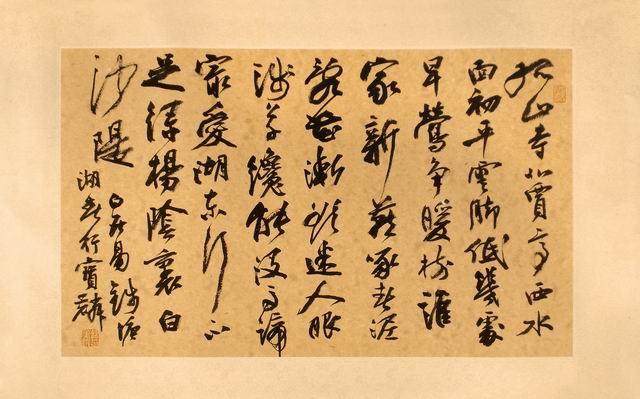
Watch this video clip of Chinese calligrapher - Cao, Bao Lin writing Chinese characters in the "grass" style - a more abstract and carefree style in Chinese calligraphy.
Cao, Bao Lin writing Chinese characters

4. Modern Chinese Interior Decoration - April 2010
Modern Chinese interior decorating uses simple, clean lines and a very modernist, almost minimalist look. A modern Chinese luxury interior will be very influenced by postmodernist thinking - so the furniture will be modern or neo-Traditional, the colors with be whites, blacks, and greys, and the layout of the rooms will be clean and open.
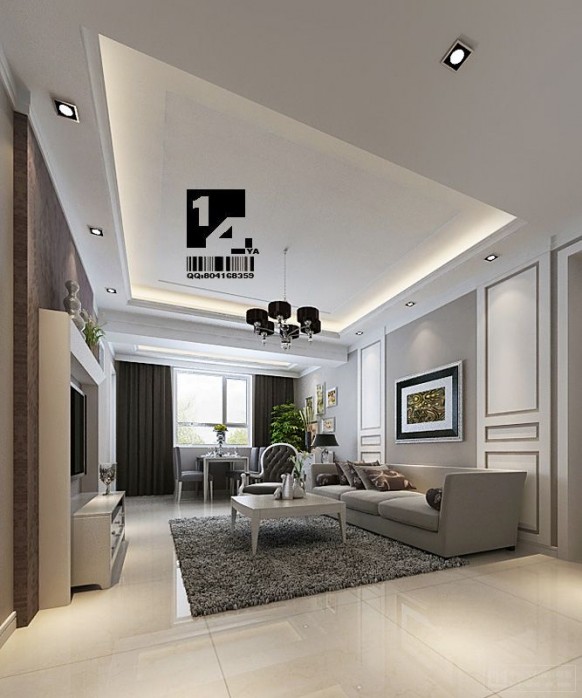
picture courtesy 14 YA, a Chinese interior design company.
This differs from the Traditional Chinese luxury homes of the past, in the days of feudalism and the Ming and Q'ing dynasties, when furniture was ornate, almost what we Westerners would call rococo - carved with natural themes (monkeys, dragons, and carp were favorites) and heavily brocaded with elaborately patterned fabrics and soft, fringed and tasseled cushions. In a Classical Chinese interior, the dominant color would be deep shades of red (red is a lucky color in Chinese folklore and folk culture) for paint and fabric, gold accents, and dark reddish brown for furniture. Chairs would sometimes have carefully, intricately woven backs and would often be oversized.
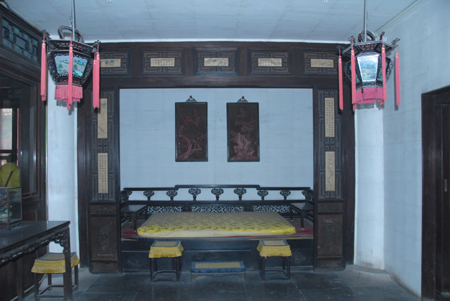
Modern Chinese luxury decorating favors simplicity and discipline - it is part of Chinese culture that discipline in all things is a means to success. ( Although most Chinese don't think of themselves as especially disciplined until they reach America and see us up close - for instance open losses of temper or control and direct person to person violence are virtually *unknown* in China. "Bar fights" simply don't happen.). So not only do you see a lot of blacks, whites, and shades of grey, but a lot of the furniture is clear glass or Lucite or similar materials.
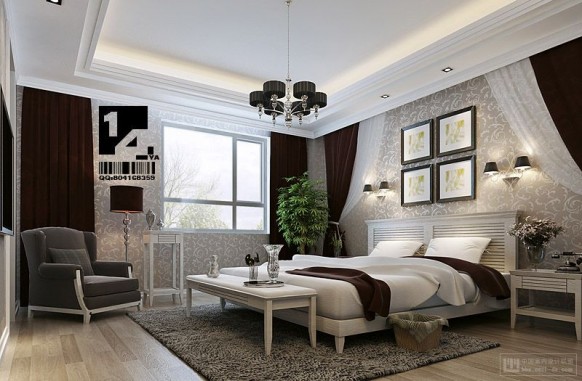
picture courtesy 14 YA, a Chinese interior design company.
One of the goals of a modern Chinese interior decorator is to create openness and space. But they don't do it with curves, the way you might find in a circa 1970s house in Los Angeles or Topanga Canyon. They create flow by using straight lines and sharp edges that lead the eye to an infinite point - usually a window, but sometimes a television or an opening into another room.
However, modern Chinese decorating makes good use of colorful accents - intricate cloisonne vases, oil hangings or scrolls, or cinnabar plates. They use these as anchor points to "open the room along the folds" as it were. The colorful anchor points outline the room - they place them on side tables, end tables, and shelves set into the wall. There is an interesting company that does Chinese oil hangings and custom Chinese calligraphy - you can have anything you want translated and done in Classical Chinese calligraphy.
And the cloisonnes and cinnabar plates and accents you can get from us. They really work wonders to open up a room and add color. The modern Chinese view a room as a clean clear canvas, which they add greys and a few splashes of color to set the borders and boundaries. It's an interesting style based in the Chinese ideals of discipline, grace, and delicate strength.

3. Qing GuangXu five principles hat hanger by Xuepeng Liu & Dave Berlin, March 2010
Chinese culture is often subtle if not mysterious to westerners. A lot of social rules are implied and not explicit, and are symbolized in arts, literature and folk customs. For example, bright golden yellow symbolizes the imperial authority, dragons symbolize power, fish symbolize prosperity since the pronunciation of the word "fish" is close to the word for abundance. Pigs symbolize wealth since they were traded as rare merchandise in ancient times (for a variety of geographic reasons, pig and hog farming is not easy in China) etc.
The antique piece we are looking at here is a late Qing dynasty hat hanger. It's made of white porcelain. The hat hanger is a perfect cylinder with hollowed core. Middle and upper class men in Qing dynasty open wore a hat shaped like a hemisphere in cold weather. The hat hangers were usually placed in the foyer of the house so hats could be left on them while men were indoors.
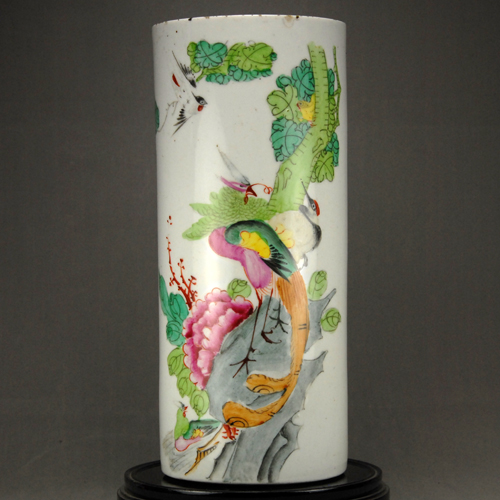 |
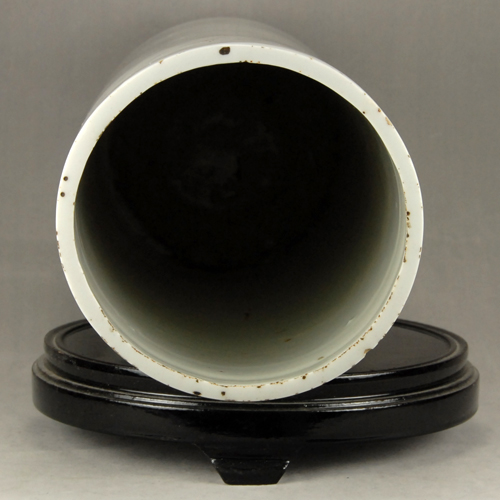 |
These are pictures of the front view and inside of the hat hanger.
This particular hat hanger is 11.6 inches high. The outside diameter is 4.72 inch. Since it's hollow on the inside, it can be used in modern days as a flower vase. The outside wall of the hanger is painted with Fencai. Fencai is a type of vibrant, richly colored pigments that form translucent, hard enamels after firing.
Hat hangers were first made in the mid 19th century. They became one of the most important dowry items when women married and left their father's homes. Hat hangers were owned by members of most social classes, since they were not very expensive to own. When you hold one in your hand and look at it, you get a glimpse of 150 years of folk cultures in China.
"Lun" in Chinese stands for principles, especially when it comes to relationships between people. In China, we say that there are five different kinds
of basic relationships between people.
1. The relationship between the emperor and his subordinates
2. The relationship between father and son
3. The relationship between husband and wife
4. The relationship between brothers
5. The relationship between friends
Meng Zi, an ancient scholar whose ideas were adopted and used by the Chinese rulers taught the five principles as below
1. the subordinates should always assist and obey the emperors2. father and son haved a natural responsibility to care for each other
3. husband and wife should care and respect each other but take different responsibilities in the family, the husband deals with the outside world and financial issues, the wife takes care of the household
4. brothers should watch out for each other and fight shoulder to shoulder against outsiders
5. friends should trust each other and be honest with each other
Ancient Chinese culture uses five species of birds to symbolize these five principles. These five principles were the basis of the moral standards promoted by ancient rulers and followed by people. People could find themselves in real trouble if they chose not to follow these standards.
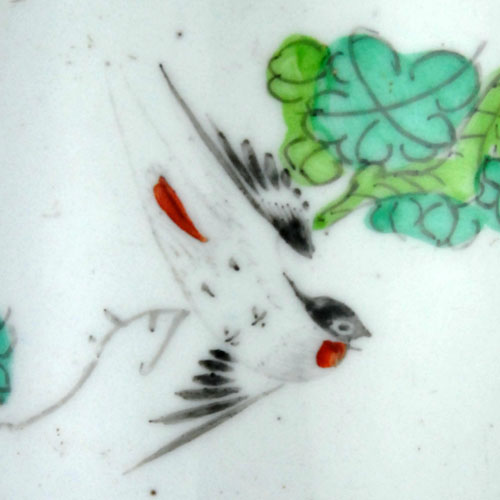
This is a picture of a wagtail, which symbolizes brotherhood.
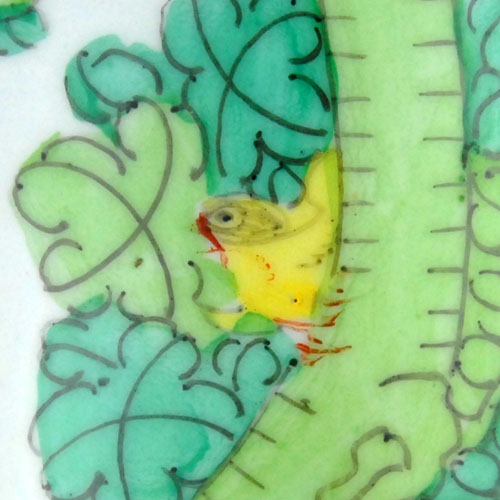
This is a picture of a yellow lark, which symbolizes friendships.
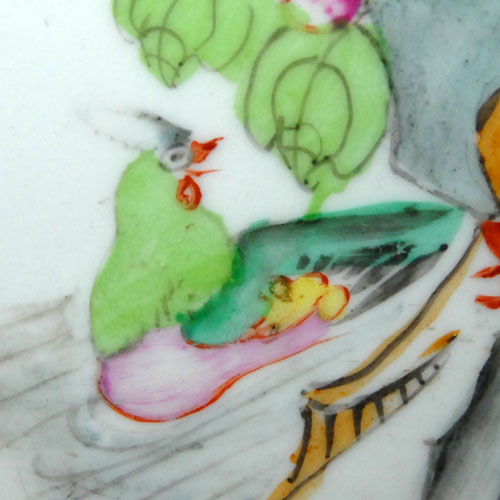
This is a picture of a duck, a pair of ducks symbolizes husband and wife.
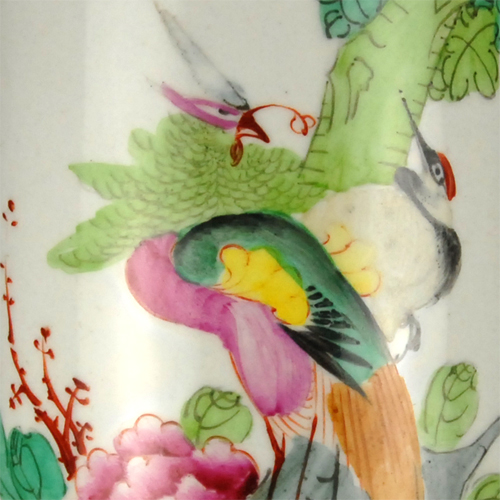
This is a picture of a phoenix, which symbolizes the emperor and his subordinates; and a white crane, which symbolizes father and son.
The hat hanger has all of these birds painted around its outside wall. The paintings serve as a reminder to the viewers that they should always follow these five principles when interacting with other people in society.
It was at times a burden or invisible cage for people living in the old times--they had no freedom to follow their hearts; they had to follow these moral standards. But they were the perfect devices for the emperors to use to set up a functional society. These principles helped the imperial emperors govern. In modern China, these principles have been long abandoned and nobody is bond to follow them anymore.

2. The Dao De Ching - March 2010
The Dao De Ching is reputed to be the teachings of a man named "Lao Tse". It was first written down by someone purporting to be him about two hundred years after he allegedly lived, in 300 BC or thereabouts.
The Dao De Ching is the teaching of a path, or a "way" that requires that people live in harmony with the natural order of the universe. Lao Tse, a librarian in the court of the Emperor, developed the idea of "wu wei" or "do not do". Lao Tse believed that the Universe had a certain order, and to take direct action invariably ran someone up against the order of the Universe.
A good way to Westernize this concept is to say that Lao Tse believed that the Universe "wanted" something and the best thing to do was go along with it. In modern American terms, minus the multileveled and layered subtexts rendered in the original classical Chinese of the written Dao texts, we say that "God is trying to tell me something..." or "I guess it wasn't meant to be." Lao Tse believed that the thing for people to do was to learn experimentally what was meant to be or what the Universe was trying to tell them, and then go in harmony with it.
The Dao De Ching is written in classical Chinese calligraphy and is difficult to translate into English--most modern Chinese do not have the necessary depth of background in the classical Chinese literature canon. Since the Dao De Ching makes a lot of allusions to this canon of literature--which any educated noble Chinese of Lao Tse's time would have known--it is hard for both modern Chinese and Westerners to translate. Also, often modern Chinese will know the modern meanings of certain characters but not the ancient meanings, which may be only distantly related or have much subtler shades of meaning.
The Dao De Ching is divided into two parts: The Dao Ching and the De Ching. The earliest known copy was written on bamboo slips and was found on an archaeological dig at Guodian, near the old Chu capital in modern day Hubei province.
You can see the photographed Guoding Laozi with translation here.
When the Guoding Laozi (the Dao De Ching was originally called the Laozi) was discovered in a tomb in 1993, it was called " ...like the discovery of the Dead Sea Scrolls," by Tu Weiming, director of the Harvard Yenching Institute. The Guoding Laozi was discovered in what was believed to be a tomb of a tutor of a noble prince, Crown Prince Heng, who became the Chu king Qingxiang, ruling from the capital, Ying. The slips contained, among other writings, 24 chapters of the current Dao De Ching and 8 chapters that contain parts of the modern text.
Included below are two photographs of a copy of the Dao De Ching from the 12th Century, copied during the Yuan Dynasty.
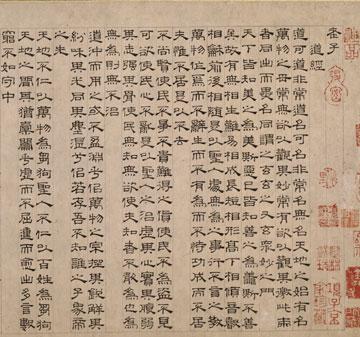
This is a photo of the very beginning of the Dao Ching.
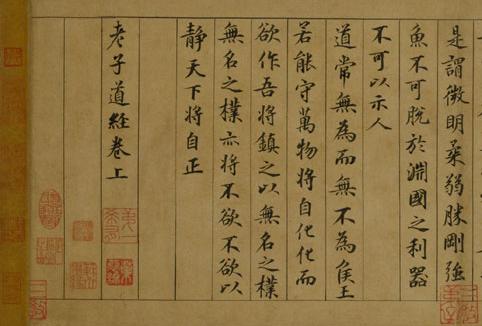
This is a photo of the end of the Dao Ching.
Notice in these two photos the red characters made by the seals of the scholars who copied and constructed the books. The seals were a kind of signature, much like an e-mail signature line today.

1. Buddha head made of elephant bone in East Han dynasty - Feb. 2010
Buddhism originated in India in 5th century BC. It was essentially the teachings of the Prince Siddhartha Guatama, who traveled throughout the Ganges River plain in India, spreading his ideas that a higher state of existence could be achieved by meditation, the proper ordering of one's karma, and a "Middle Way"--neither completely renouncing the world nor living in it materially to excess.
Buddhism spread East from India to China during the East Han dynasty (25-200 AD). Early on in the East Han dynasty, Buddha statues made in China imitated the style of Indian Buddhas. Statues and other works of art depicting the Buddha did not differ much between China and India.
It was not until the Wei Jin period (A.D. 220-420) that Buddha art evolved in China to reflect the characteristics specific to Chinese culture and Chinese Buddhism.
This carving was done using the technique called "Han Eight Cuts" or "Cut Eight Times".
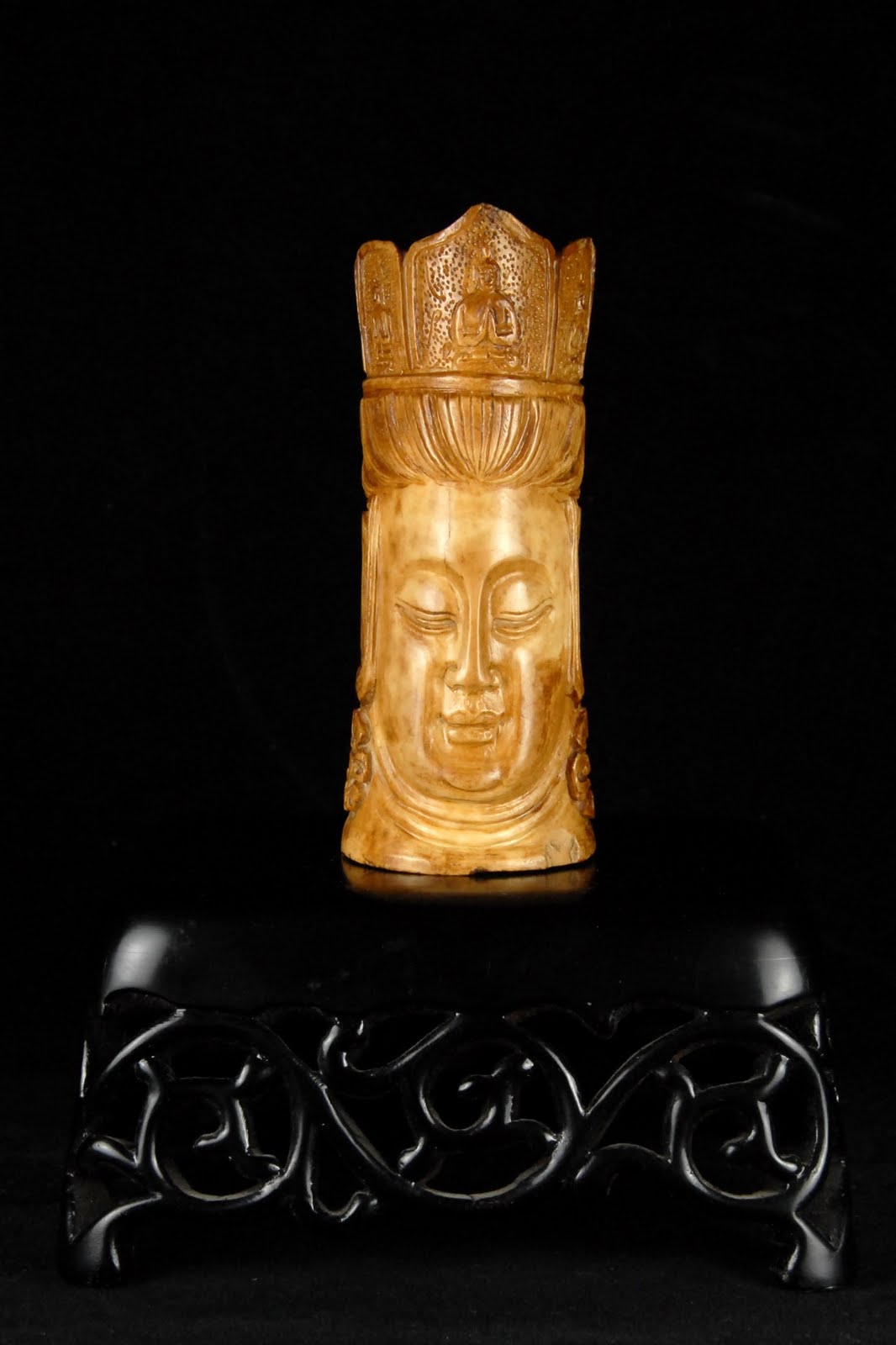
Han Eight Cuts was a technique used in jade caring that was invented during the Han dynasty. Artists during the Han dynasty tended to emphasize an object's shape much more than its texture. They didn't worry so much about making edges and curves smooth and surfaces flat and smooth. Eight Cuts would form the main outline of a jade object with eight simple strokes of a knife. The idea is similar to sketching the outline of an object with a few lines in a graphite drawing.
Only the greatest most skilled artisans with the best training and the deepest spirit were able to carve an object with this technique. Their artwork is considered priceless and very hard to find.
This particular Buddha's head carving is in the collection of My Crystal Bridge Arts and Crafts co-founder Xuepeng Liu's. This head was carved of elephant bone--from the throat of an elephant--during the East Han dynasty. The material was a piece of bone from the throat of an elephant. It was carved more than 2000 years ago and is already fossilized. The yellowed bone has become hard and has an oily look and feel from 2000 years of human handling. The carving is vivid and is fluently done--it has a good flow to it--to reflect the deep influence Buddhism had on people's thinking at the time.
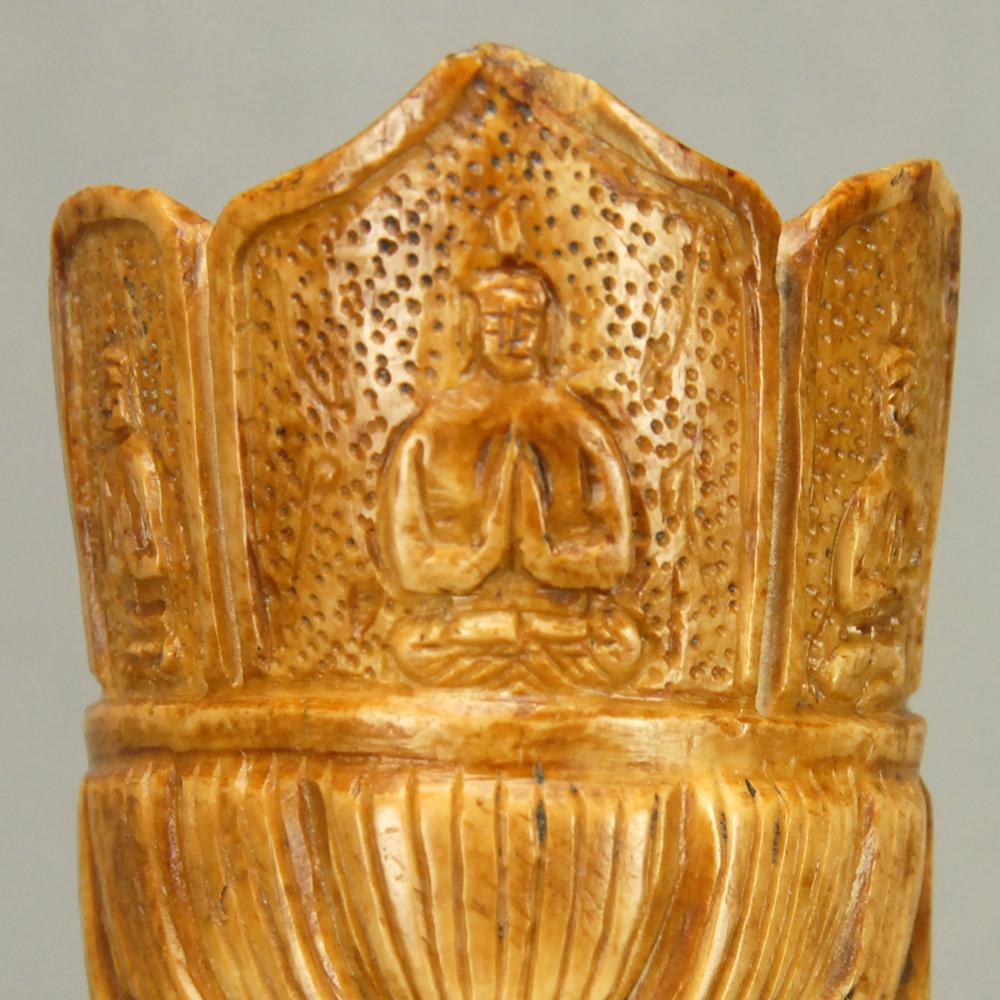
There are three smaller sitting Buddhas on the crown of the Buddha's head. These smaller Buddhas' faces were carved using the Han eight cuts technique. These eight brief carvings outlined the Buddhas' facial features. Also, since these smaller Buddhas are not the center of the object, the simple carvings pushed them to the background to leave the focal point to the actual Buddha head.
This Buddha head was something an ancient monk carried with him when traveling, it's also called a companion Buddha. The Buddha head came to East Han's territory with this ancient monk and stayed to today for us to appreciate it.
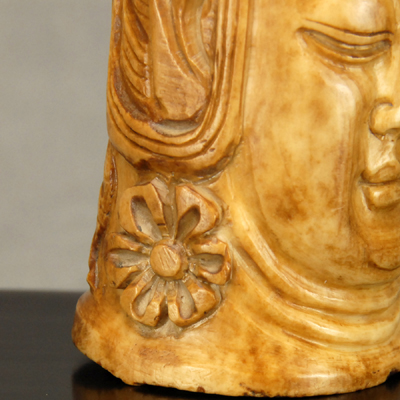
The Buddha head is about 4 inch high and weighs about 4 oz. It's located in Beijing, China.
Disclaimer: This particular antique is not available for sale. It is presented here purely for educational and informational purposes. Chinese law prohibits the sale of Chinese antiques made prior to the 1840s outside of China.

